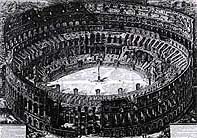Piranesi
| "Seeing that the remains of the ancient buildings of Rome, scattered for the most part in gardens and fields, are being day by day reduced by the injuries of time or by the greed of their owners who, with barbarian licence, secretly demolish them to sell the rubble for modern houses, I decided to preserve them in these plates." - Piranesi. Preface to Antichita. |
Giovanni Battista Piranesi was the son of a Venetian stone mason. He trained as an architect, printmaker and theatrical set designer. In 1740, Piranesi moved to Rome where he developed an interest in classical antiquities. At this time Rome was smaller than it had been at the height of the Roman Empire. The huge ruins were overgrown and peasants grazed their flocks around the ancient monuments. The architectural achievements of the Romans and the subsequent decay of their monuments both made a great impression on Piranesi.
The etchings on display in this exhibition are from the Vedute di Roma (Views of Rome), and the Antichita Romane (Roman Antiquities) series. They were presented to the Library by Dr. Charles Brasch in 1966-67 not long after the Library moved from the clock tower building into its current premises. Some of Piranesi's early views were first published in guide books to Rome. In this respect these etchings complement the large collection of pre-1800 guide books to Rome held in the Library's de Beer Collection.
Items displayed
- Veduta dell interno dell' Anfiteatro Flavio (interior view of the Flavian Amphitheatre).
- Veduta interna della Villa di Mecenate dall iscria... (Interior of the Villa of Maecenas at Tivoli), 1764.
- Veduta del l'arco di Benevento nel regno di Napoli (The Arch of Beneventum), 1778.
- Veduta dell'avanzo del Castello, che prendendo una porzione dell'Acqua Guilia dal Condoto principale (Fountain of the Acqua Guilia and the gate of the Villa Palombara), 1753.
- Veduta dell' anfiteatro Flavio detto il Colosseo (View of the Flavian amphitheare, called the Colosseum), 1776.
- Sepolcro di Cecilia Metella (The Tomb of Caecilia Metella), 1762.
- Rovine del Sisto, a sia della gran sala delle terme Antoniniane (Ruins of the Xystus, the central hall of the Antonine Baths), 1765.
- Veduta degli avanzi superiori delle Terme di Diocleziano (View of the remains of the Baths of Diocletian), 1774.
- Veduta della fonte e dette Spelonche d'Egeria fuor della porta Capena or di S. Sebno (The fountain and grotto of Egeria outside Porta Capena), 1766.
- Ornamenti di Stucco, esistenti nella Volta della Stanza Sepolcrate di L. Arrunzio (Stucco decoration in the tomb chamber of L. Arruntius), 1756.
- A muro interna della Stanza, costrutto di mattoni della stessa grandezza, che qui sono disegnati contale sodezza, connessione, ed artificio, che ben vi si conoscono tutte le regole, le quali sono state descritte da Vitruvio per costruire i mattonati (Interior wall of the funerary room), 1756.
Links
Complete list of Piranesis in Special Collections
|
|
|
| Piranesi, Giovanni Battista,
1720-1778. Veduta dell' anfiteatro Flavio detto il Colosseo (View of the Flavian amphitheare, called the Colosseum), 1776. From the series Vedute di Roma. Charles Brasch estate. Special Collections, Central Library. |
|
